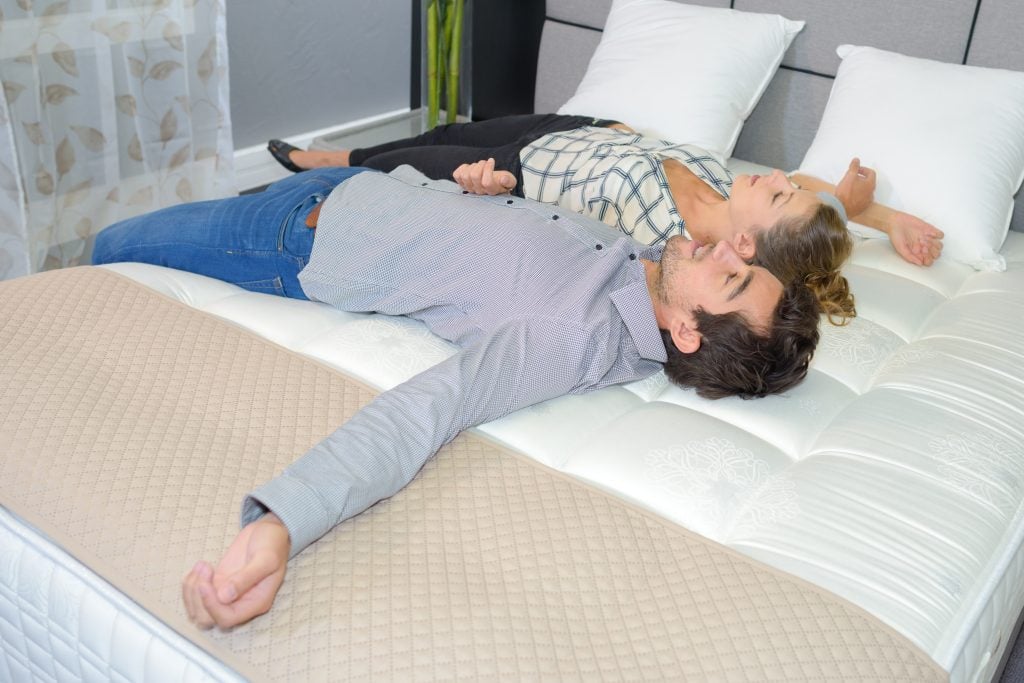Considering the many mattress types on the market, the different benefits and the range of tensions to choose from, it can be challenging to settle on the perfect mattress for you. With this in mind, many people purchase a mattress that is either too soft or too firm for their liking. Our blog discusses what actions to take if your mattress is too soft and how to settle on your perfect mattress.
Below, we discuss which sleeping positions and body statures are best suited to which mattress types, ensuring you can determine if your current mattress is the right fit. A key indication you’re sleeping on an unsuitable mattress is if you wake up every morning suffering from minor aches and pains, particularly in the lumbar region.
Regardless of your sleeping position, you shouldn’t experience a sinking feeling when lying in bed, except for memory foam, latex and gel foam mattresses that are engineered to offer this sensation. Any high-quality mattress will sufficiently support your body weight throughout the night, provided it fits your sleeping preferences and requirements.
The importance of a mattress cannot be overstated when you consider that it goes a long way to determining how well-rested you feel every morning and can set a precedent for the day ahead. If your mattress doesn’t allow for both good sleep quality and quantity, you risk feeling tired and in minor pain. In fact, research suggests if your pain is worse when you wake up and improves throughout the day, it’s a good sign your body is not getting the proper rest it needs throughout the night.

Provided you don’t own a single-sided mattress, ensure you rotate and flip your mattress approximately every three to six months. By utilising both sides of the mattress, you’ll ensure the fillings are evenly distributed and place less strain on a single side. Similarly, by rotating the mattress, you can apply pressure to the entire surface area, reducing the risk of an uneven or sagging mattress. As long as your mattress isn’t too soft or sagging before you rotate and flip the mattress, these simple manoeuvers could enhance the mattress’ longevity.
If you’re a front or back sleeper, the best solution to sleeping on a mattress that is too soft is to change your sleeping position. Below, we provide insight into which mattress tension is best suited for different sleeping positions; alternatively, for further insight, take a look at our ‘What mattress tension do I need?‘ blog.
When sleeping on your side, it’s important the mattress can cushion your hip and shoulder; with this in mind, we recommend soft, medium or medium firm mattresses for side sleepers.
Your body stature will also influence which tension you opt for. For those of a lighter stature, a soft or medium mattress will be ideal, whereas if you’re of a larger build, consider a medium firm mattress.

Conversely, a firm or extra firm mattress is ideal for anyone who sleeps on their front or back. When sleeping in these positions, it’s important the mattress is firm enough to evenly distribute body weight and support the spine. If you’re a front and back sleeper and are concerned your mattress is too soft, we recommend switching to sleeping on your side to avoid sinking into the mattress. As The Sleep Advisor explains, ‘if you sleep on your stomach or back, you might be putting too much pressure on your spine if your mattress is too soft and you sink right in’.
Medium firm mattresses are often regarded as ‘all-rounders’ as they’re soft enough for side sleeping yet can also accommodate front and back sleeping.
Replacing your mattress is easier said than done, and we recognise how expensive this can be. However, if your mattress shows signs of wear and tear or is too soft and you’re reluctant to sleep on your side, we recommend replacing your mattress. As mentioned above, your mattress goes a long way in determining the quality of your sleep. As a rule of thumb, your mattress should be replaced every eight years to facilitate a comfortable and supportive night’s sleep.

If you take your time and research before purchasing a mattress, we’re confident you’ll be able to settle on the perfect mattress. First and foremost, decide which tension is best suited for your body stature and sleeping position and from here, you can choose which mattress type you’d prefer. Our user-friendly website categorises our mattresses by type, benefits, brand and more to ensure a straightforward shopping experience. Information outlining the appeal of different mattress compositions, such as memory foam and pocket springs, can be found underneath the product’s description to provide further insight.
We understand purchasing a mattress online can be challenging, and with this in mind, any mattress purchased alongside a mattress protector is eligible for our 60-night sleep trial. This allows you to shop with confidence, knowing you can replace your mattress if necessary.